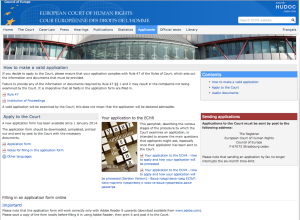 The European Court of Human Rights (ECtHR) has confirmed that the implementation of Protocol No. 14 to the European Convention on Human Rights over the past three years has reduced its case backlog, particularly among the nearly 90% of applications deemed inadmissible. [ECtHR Press Release]
The European Court of Human Rights (ECtHR) has confirmed that the implementation of Protocol No. 14 to the European Convention on Human Rights over the past three years has reduced its case backlog, particularly among the nearly 90% of applications deemed inadmissible. [ECtHR Press Release]
One of the main challenges confronting the Court is the sheer volume of cases it receives and must process. Protocol No. 14, which entered into force on June 1, 2010, introduced new procedures to more efficiently handle cases that clearly fail to meet the admissibility requirements or can be struck out without further examination. Protocol No. 14 allows for Single Judges – as opposed to three-judge panels – to dispose of such cases with the assistance of rapporteurs. It also established a new admissibility criterion for cases, requiring that applicants demonstrate having suffered a “significant disadvantage.” Protocol No. 14 also extended a judge’s term of office to a non-renewable nine-year term. [ECtHR]
A Filtering Section composed of Single Judges and Registry rapporteurs has been tasked with handling all incoming applications and allocating them among the Single Judges, three-judge Committees, and Chambers. The Filtering Section began operating in early 2011, with the express goal of streamlining processing of applications concerning the five countries with the highest number of complaints: Russia, Turkey, Romania, Ukraine and Poland. ECtHR For a concise explanation of the Court’s case processing procedure, see its simplified flow chart
Taken in conjunction, these methods have reduced the number of cases allocated to each Single Judge. On October 1, 2013, the backlog of cases allocated for examination by a Single Judge had dropped to 38,200 from over 100,000 in 2011. The total number of cases pending before the European Court has dropped to 111,350 from its peak of 160,200 cases on September 1, 2011. [ECtHR Press Release]
The European Court will continue following Protocol No. 14 in handling incoming applications. The ECtHR is also currently pursuing other available means of improving its working methods to continue coping with its existing case backlog and foreseeable future caseload, while still being able to maintain the quality of its work.
For more information about Protocol No. 14, other reforms underway at the ECtHR, and their effects on the Court’s functionality, please visit the ECtHR’s webpage on the history of the Court’s reforms.
